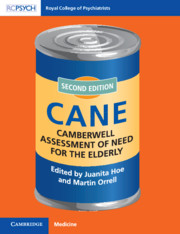Book contents
- Camberwell Assessment of Need for the Elderly
- Camberwell Assessment of Need for the Elderly (CANE)
- Copyright page
- Contents
- Figures
- Tables
- Contributors
- Acknowledgements
- Chapter 1 An Introduction to Needs Assessment and Use of the Camberwell Assessment of Need for the Elderly
- Chapter 2 Self-Reported Needs of People with Dementia Living at Home
- Chapter 3 Needs of Older Primary Care Patients
- Chapter 4 Unmet Needs of Older Persons with and Without Depression in Residential Homes
- Chapter 5 Needs of Older People Living Alone
- Chapter 6 Needs Assessment of People with Dementia and Impact of Caregiver Burden
- Chapter 7 Crisis and Assessment of Need in Dementia
- Chapter 8 Needs of People with Young-Onset Dementia
- Chapter 9 Needs of Older People in Long-Term Care Settings
- Chapter 10 Needs and Healthcare Costs in Old Age
- Chapter 11 The Future of Needs Assessment Research
- Instructions for the CANE
- Index
- References
Chapter 3 - Needs of Older Primary Care Patients
Published online by Cambridge University Press: 10 June 2021
- Camberwell Assessment of Need for the Elderly
- Camberwell Assessment of Need for the Elderly (CANE)
- Copyright page
- Contents
- Figures
- Tables
- Contributors
- Acknowledgements
- Chapter 1 An Introduction to Needs Assessment and Use of the Camberwell Assessment of Need for the Elderly
- Chapter 2 Self-Reported Needs of People with Dementia Living at Home
- Chapter 3 Needs of Older Primary Care Patients
- Chapter 4 Unmet Needs of Older Persons with and Without Depression in Residential Homes
- Chapter 5 Needs of Older People Living Alone
- Chapter 6 Needs Assessment of People with Dementia and Impact of Caregiver Burden
- Chapter 7 Crisis and Assessment of Need in Dementia
- Chapter 8 Needs of People with Young-Onset Dementia
- Chapter 9 Needs of Older People in Long-Term Care Settings
- Chapter 10 Needs and Healthcare Costs in Old Age
- Chapter 11 The Future of Needs Assessment Research
- Instructions for the CANE
- Index
- References
Summary
In old age, morbidity and the proportion of chronically ill patients in primary care increase. Because of multi-morbidity, older people belong to the population group with the highest use of medical services, and the general practitioner (GP) is usually the first contact point for older people.1 According to current data, the age group between 70 and 79 years shows the highest levels of utilisation of primary care services (12-month prevalence) in registered doctors’ practices with a population share of 83.4%.2 Because GPs have the highest share of medical care, they play an important role in the care of somatic and mental illness in old age. In the field of mental health in old age, dementia and depression belong to the most common disorders. Further, cardiovascular diseases and musculoskeletal disorders are among the most common physical illnesses in individuals over 75 years of age.3,4 These diseases cause not only great suffering for the affected patients but also high costs for the healthcare system.
- Type
- Chapter
- Information
- Camberwell Assessment of Need for the ElderlyCANE, pp. 20 - 33Publisher: Cambridge University PressPrint publication year: 2021

